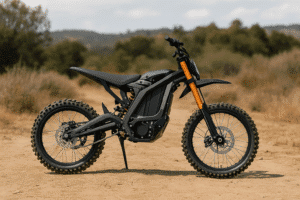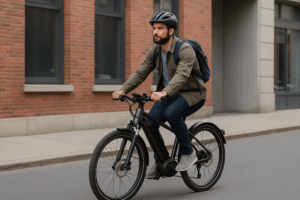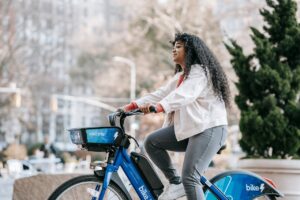It’s a common question with a surprising answer. While it sounds great in theory, most electric bikes don’t actually charge when you pedal. A few rare models use regenerative braking or other energy-recovery tricks, but the effect is small.
Let’s break down what really happens when you ride.
TL;DR
Most e-bikes don’t charge when you pedal. Your pedaling helps conserve battery but doesn’t refill it. Some models use regenerative braking, which can recover about 5–10% extra energy, but it only works in specific setups. For now, plug-in charging is still the main method.
How Do Electric Bikes Normally Charge?
Electric bikes charge by plugging their batteries into a power outlet, just like charging a phone or laptop. The most common method is using a standard charger that connects directly to the e-bike’s removable or built-in battery.
Most e-bikes take about 3 to 6 hours to charge fully, depending on battery size. Some higher-end models come with fast-charging options that cut this time in half.
While many riders hope pedaling could recharge the battery, that’s not how most e-bikes are designed. Instead, they rely on efficient lithium-ion batteries that need external charging to keep you moving.
Do Electric Bikes Charge When You Pedal?
No, most electric bikes do not charge when you pedal. The energy you put into pedaling helps move the bike forward, but it does not generate enough electricity to recharge the battery.
Some people assume that since pedaling requires effort, it must somehow refill the battery. But in reality, the motor and battery system are separate from your pedaling power.
When you ride, your legs are doing the work alongside the motor, making your battery last longer, but not charging it. There are a few experimental designs trying to change this, but they’re not widely available yet.
How Regenerative Braking and KERS Work in E-Bikes

Regenerative braking is a system that recovers some of the energy lost when slowing down and feeds it back into the battery. Instead of letting that energy escape as heat, the motor briefly switches into generator mode, converting the motion into electricity.
This is the same principle used in electric cars, but with one big difference—e-bikes don’t generate nearly as much braking force, so the energy recaptured is minimal.
A more advanced version of this is the Kinetic Energy Recovery System (KERS), which works in a similar way but is designed to optimize how energy is stored and used.
KERS is commonly found in high-performance vehicles like Formula 1 cars and has been adapted for some e-bikes to improve efficiency.
For either system to work, an e-bike must have a direct-drive hub motor. Unlike the more common mid-drive or geared hub motors, direct-drive motors allow energy to flow back into the battery.
But there’s a trade-off—they’re heavier, create resistance when pedaling without power, and aren’t as efficient for most riding conditions.
While regenerative braking sounds like a great idea, the reality is that most e-bike riders won’t notice a huge difference. Even in the best conditions—like frequent stop-and-go riding in the city—regenerative braking might extend battery range by just 5-10%.
For most people, investing in a larger battery or a second battery is a far better way to get more mileage out of an e-bike.
Experimental Self-Charging E-Bike Technologies
While most e-bikes don’t charge when pedaling, a few innovative models are trying to make it happen. These bikes use different methods to capture energy and store it in the battery:
- Byar Volta – Charges the battery when you backpedal.
- Pi-Pop – Uses a supercapacitor instead of a traditional battery, storing energy as you pedal.
- Vello Bike+ – A lightweight folding bike that recharges on descents and braking using a kinetic energy recovery system (KERS).
These are exciting developments, but they’re still rare and often expensive.
Why Regenerative Charging Is Not Common in E-Bikes
Self-charging sounds great, but there are reasons why most e-bikes don’t have it.
Requires a Direct-Drive Hub Motor
Most e-bikes use geared hub motors or mid-drive motors because they’re lighter and more efficient. Regenerative braking only works with direct-drive hub motors, which are bulkier and create resistance when pedaling without power.
Low Energy Recovery
Unlike cars, e-bikes are lightweight, meaning they don’t generate much kinetic energy during braking. Even with regenerative braking, most riders only get 5-10% extra range, which isn’t enough to replace regular charging.
Added Cost with Little Benefit
Including regenerative braking in an e-bike increases the cost, but the small energy savings don’t justify the higher price for most riders. Investing in a larger battery is a much better way to increase range.
Makes Pedaling Harder
In bikes with regenerative braking, you might feel extra resistance when pedaling without motor assistance. This is because the direct-drive motor creates drag, making it less enjoyable to ride without power.
The Future of Self-Charging E-Bikes
While today’s e-bikes don’t charge efficiently from pedaling, future advancements could change that. Some companies are exploring better energy recovery systems, lightweight supercapacitors, and even solar-powered e-bikes to improve self-charging technology.
For now, plugging your e-bike into a charger is still the best way to keep it running. If you’re looking to extend battery life, consider riding in eco mode, using pedal-assist efficiently, or carrying a spare battery.
Regenerative braking and pedal charging may improve over time, but for now, they’re more of a bonus feature than a game-changer.
Final Words
So, do electric bikes charge when you pedal? Not really. Most e-bikes don’t have the technology to turn your pedaling effort into battery power.
While some models use regenerative braking to recover a little energy when slowing down, the amount is small—certainly not enough to replace regular charging.
A few experimental designs, like the Byar Volta and Pi-Pop, are testing ways to create self-charging e-bikes, but they’re far from mainstream.
Right now, the best way to keep your e-bike running longer is smart battery management—using pedal assist wisely, riding in eco mode, and carrying a spare battery if needed.
While self-charging e-bikes may become more practical in the future, today’s technology just isn’t there yet. For now, plugging into an outlet is still the way to go.
FAQs
Can you really charge an electric bike by pedaling?
Not with most models. Standard e-bikes don’t convert pedaling into battery power. A few rare bikes try to do it, but the energy recovered is minimal.
Which electric bikes have regenerative braking?
Only certain e-bikes with direct-drive hub motors support regenerative braking. Examples include bikes like the Vello Bike+ or Byar Volta. Most e-bikes with mid-drive or geared hub motors do not support it.
Is regenerative braking worth it on an e-bike?
Usually not. It only adds a small amount of battery back, typically around 5% to 10% extra range in ideal conditions. It’s more of a bonus feature than a replacement for regular charging.
How much energy does pedal charging recover?
Very little. Even with regenerative systems, the energy recovered while pedaling or braking isn’t enough to make a big difference. Most riders won’t notice a major increase in battery life.
Why isn’t self-charging common in e-bikes?
Because the trade-offs aren’t worth it. Self-charging needs heavier motors, adds drag when pedaling, and increases the cost, all for very limited energy recovery. Most riders prefer larger batteries or swappable power packs instead.
Michael Josh is a hands-on e-bike tester and reviewer at BoltBikers, known for putting every model through real-world rides before sharing his thoughts. With a sharp eye for performance, comfort, and build quality, he helps the team choose which bikes are worth featuring. Backed by years of experience in tech and gear reviews, Michael brings trusted, honest insights to help readers find the right e-bike for their needs.








